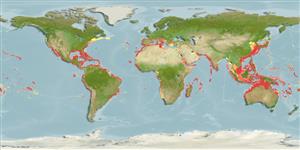Classification / Names
Common names from other countries
Main reference
Size / Weight / Age
Max length : 190 cm TL male/unsexed; (Ref. 3397); common length : 100.0 cm TL male/unsexed; (Ref. 3197); max. published weight: 80.6 kg (Ref. 3287); max. reported age: 15 years (Ref. 113943)
Length at first maturity
Lm 99.5, range 80 - 127 cm
Environment
Marine; reef-associated; oceanodromous (Ref. 51243); depth range 1 - 360 m (Ref. 11441), usually 18 - 72 m (Ref. 9626)
Climate / Range
Subtropical, preferred 27°C (Ref. 107945); 45°N - 28°S, 180°W - 180°E
Distribution
Circumglobal. Indo-West Pacific: South Africa, Persian Gulf, southern Japan and the Hawaiian Islands, south to New Caledonia; Mariana and Caroline islands in Micronesia. Western Atlantic: Bermuda (Ref. 26938), Nova Scotia, Canada to Brazil; also from the Gulf of Mexico and the Caribbean Sea (Ref. 9626). Eastern Atlantic: British coast (vagrant) to Morocco and the Mediterranean. Distribution in eastern central Atlantic along the African coast is not well established due to past confusion with Seriola carpenteri (Ref. 7097).
Countries | FAO areas | Ecosystems | Occurrences | Introductions
Short description
Dorsal
spines
(total): 8;
Dorsal
soft rays
(total): 29-35;
Anal
spines: 3;
Anal
soft rays: 18 - 22. Bluish grey or olivaceous above, silvery white below; amber stripe along midside of body; fins dusky (Ref. 3197). Second dorsal and anal fins with low anterior lobe (Ref. 26938). Species of Seriola lack scutes (Ref. 37816).
IUCN Red List Status (Ref. 115185)
Threat to humans
Reports of ciguatera poisoning
Human uses
Fisheries: minor commercial; aquaculture: commercial; gamefish: yes; aquarium: public aquariums
Tools
Special reports
Download XML
Internet sources
Estimates of some properties based on models
Phylogenetic diversity index
PD50 = 0.5020 many relatives (e.g. carps) 0.5 - 2.0 few relatives (e.g. lungfishes)
Trophic Level
4.5 ±0.0 se; Based on diet studies.
Resilience
Medium, minimum population doubling time 1.4 - 4.4 years (K=0.18; tm=4; tmax=15)
Vulnerability
Moderate to high vulnerability (54 of 100)
Price category
